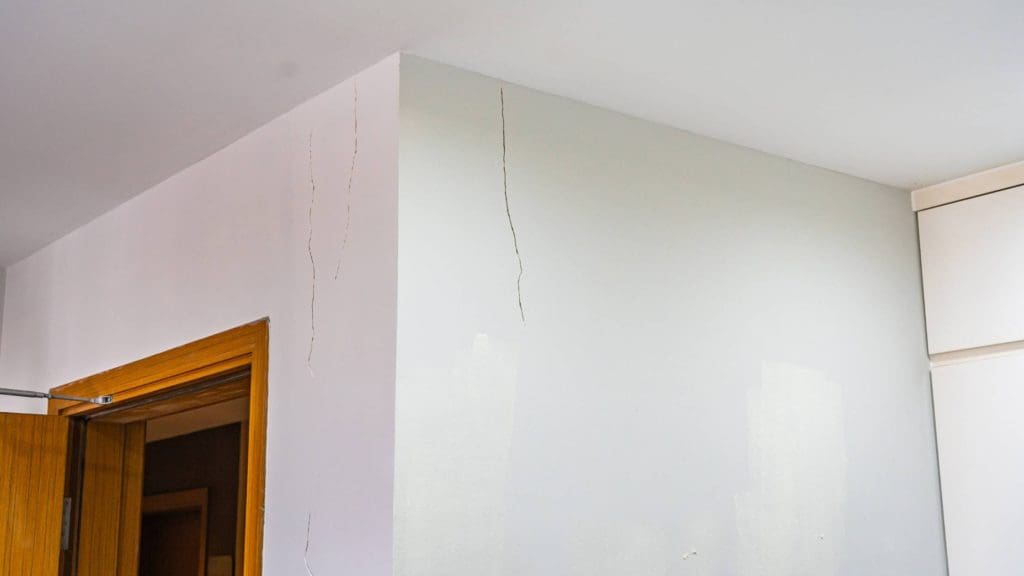If you’ve recently noticed cracks in your drywall, you probably ask yourself whether they’re dangerous or not. Although we’ll try to answer all of your questions about drywall cracks in this blog post, let’s start off with some good news: drywall cracks aren’t always flagging a serious problem. Cracks can form in drywall due to various reasons, such as improper drywall installation, changes in humidity and temperature, and normal settling of the home.
However, drywall cracks sometimes result from structural damage, which should be addressed right away. To help you identify the drywall cracks that signal foundation damage and preventcostly repairs, our specialists have put together some basic information about the types of cracks that typically develop in drywall, what might cause them, and when you should contact a foundation repair contractor.
When Are Drywall Cracks Serious?
As we just pointed out, if drywall cracks are caused by seasonal changes ornormal settling of the home, there’s usually nothing to worry about. On the other hand, if cracks appear in the drywall as a result of a structural problem, the underlying issue must be professionally addressed as soon as possible in order to reduce damage to your home.
In general, drywall cracks tend to develop around the corners of doors and windows, corners of wall openings, and between two sections of drywall. While most cracks that develop in drywall are small and thin, they’re often just a cosmetic issue, wider cracks that run at an angle or diagonally are typical indicators of a more serious problem. That being said, you should worry about cracks in drywall when:
- they run across walls and/or ceilings – Diagonal or stair-step cracks are almost always caused by thefoundation settling into wet clay soil, which is no longer able to support the weight of your home; this typically happens when clay soil absorbs rainfall until it becomes saturated;
- they’re accompanied by sagging drywall sections– A crack that forms between two drywall sections, one of which is sagging, might be a sign of bowing walls, which are also caused by foundation movement;
- you see gaps between walls and ceilings – Cracks or gaps that develop between walls and ceilings are often the results of structural damage.
Large cracks are usually signs of significant foundation problems. Because the structural components within your home will continue to settle, deflect, or deteriorate, eventually leading to extensive structural damage, any wide or diagonal crack in your drywall should be inspected and repaired by a professional as soon as possible.
Underlying Causes of Cracks in Drywall
Although thetensile, compressive, and/or bending stresses that normally occur in a home are the main reasons why hairline cracks develop in drywall, other potential causes include:
- Failing drywall seams– Vertical and/or horizontal cracks in drywall can result from improper drywall installation techniques. When joint compound, also known as drywall mud, and tape aren’t applied correctly, cracks may develop where drywall panels are joined at the seam. These cracks are usually superficial and relatively easy to fix.
- Normal settling– Normal settling is a process by which all homes gradually sink into the soil over time. This may cause a series of hairline cracks to appear especially at stress points in the drywall. Although normal settling isn’t a big deal, as most hairline cracks that develop as a result of this process are just an aesthetic nuisance, a high number of hairline cracks that affect one or more areas of your home could still indicate structural damage. In this case, you should have an experienced contractor inspect your foundation and home.
- Differential Settlement –Differential settlement occurs when the soil underneath your foundation gets very wet and soft, allowing one side of your home to sink deeper and faster than the others. Because this causes your foundation to shift, your home will no longer sit evenly on the ground. This means that all of the structural components within your home will be subject to different stresses, which will eventually cause your drywall to crack at stress points.
- Variations in temperature and soil moisture content – Water that accumulates around your foundation every time it rains along with temperature variations due to seasonal changes are some common causes of expansion and contraction of building materials. Repeated contraction and expansion cause stress to occur inside your walls, which will ultimately lead to cracks in the drywall.
Drywall cracks may also develop as a result of earthquakes, wind loads from storms, and roof truss uplift. The best way to identify the underlying causes of drywall cracks is tocall in an expert. If the cracks are caused by foundation damage, only a professional will be able to fix the issue permanently by stabilizing and reinforcing the foundation as well as any other structural elements affected.


Homeowner Questions & Allied Foundation Repair Responses
I would like to inqure about your services for crackes inside of my home.
Please fill out the estimate request form to schedule an appointment.